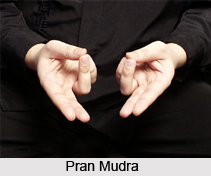 Pran Mudra is a type of Hand or Hatha Yoga practiced for myriad health benefits. Pran Mudra is said to activate the Root Chakra and improve vitality and vigour. In Root Chakra the elemental force of human entity resides. The finger position of this mudra provokes the nourishing energy in the pelvic floor.
Pran Mudra is a type of Hand or Hatha Yoga practiced for myriad health benefits. Pran Mudra is said to activate the Root Chakra and improve vitality and vigour. In Root Chakra the elemental force of human entity resides. The finger position of this mudra provokes the nourishing energy in the pelvic floor.
Practice of Pran Mudra
Pran Mudra is very easy to practice and can be performed anywhere. This mudra is performed with both the hands. The tips of the thumbs, ring fingers and little fingers are placed together and the other fingers remain extended. Pran Mudra can be practiced thrice a day for duration of 15 minutes or for around 30 minutes in a day.
While performing Pran Mudra, the thumb can also be put onto the fingernails of the other two fingers, instead of on their tips. This leads to the left and the right brain hemispheres function effectively and leaves them active.
Benefits of Pran Mudra
•The Pran Mudra increases vitality and reduces weakness in a person through regular practice.
•Practicing the Mudra can lead to diminution of fatigue and nervousness and improves vision. Moreover, immunity system is also fortified. It also improves blood circulation.
•Pran Mudra is effective in treating eye diseases.
•On mental and emotional level, Pran Mudra elevates the staying power and assertiveness, self confidence and renders courage.
•This mudra promotes the mental outlook and advances structured thoughts and ideas.
•It leads to conscious, slow and gentle way of breathing which is effective in stabilising and calming the inner cognizance.
•It decreases ailments like leg aches and pains, cervical spondylosis, sciatica and headache. It is also known to improve the nervous system and reduce cramps as well.
•Practice of this mudra improves problems related to physical weakness and exhaustion, and also eradicates insomnia, when practiced along with Gyan Mudra.
•It enhances bone and cell reproduction and purifies the blood as well.
•It is also known to provide much help to the people suffering from diabetes, paralysis, polio, Parkinson`s disease etc.
•Pran Mudra is believed to be of great help to the patients suffering from aids or cancer, as the practice of this mudra improves immunity in a person. Moreover it is also very useful to the elderly people.




















